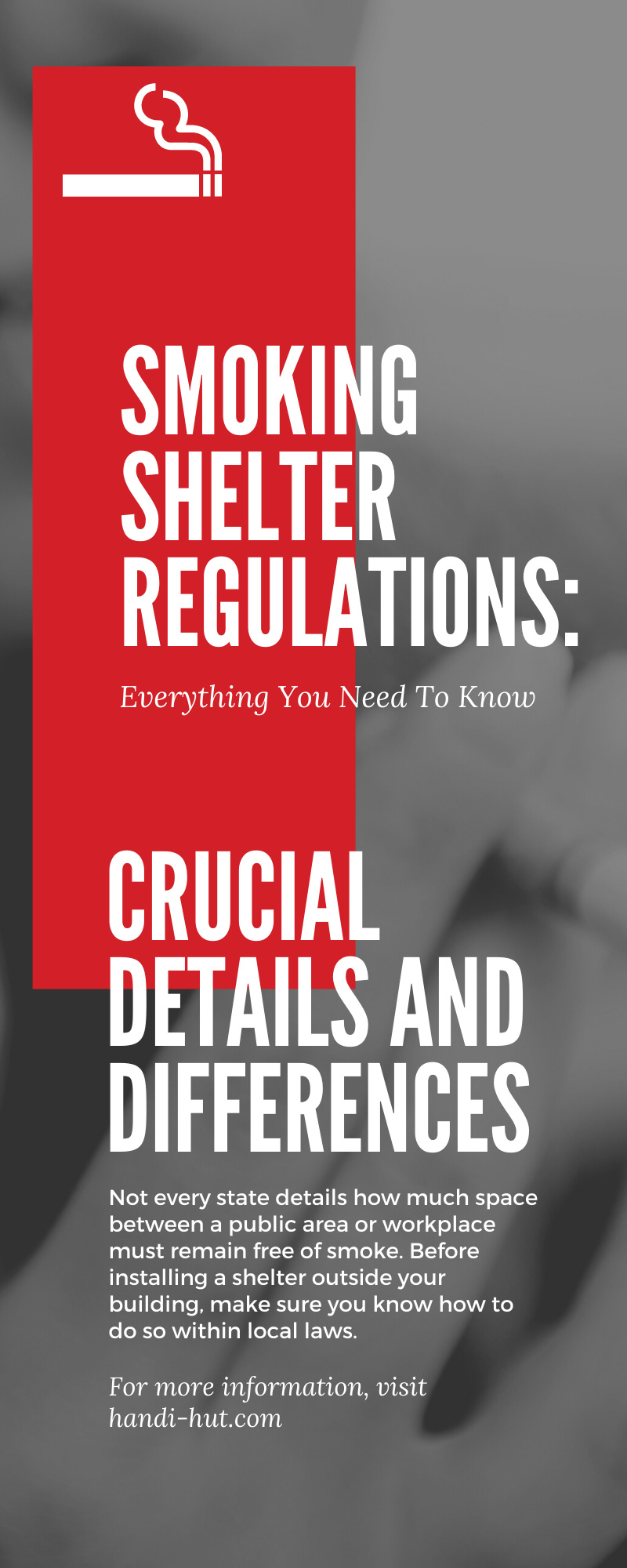
Smoking shelters, which also carry the moniker “smoking enclosures,” are distinct structures you can find around various buildings in the United States. Many times, these shelters look similar to enclosures at bus stops. The purpose of these structures is to give smokers places to smoke comfortably and away from non-smokers in public places.
Of course, some business owners might wonder what exactly their role in providing smoking enclosures is. How do you define these structures? What are the local regulations you must follow? Questions like these are essential for finding a suitable smoking shelter for your needs. If you don’t already have the answers, you can discover everything you need to know about smoking shelter regulations below.
An Introduction to Smoking Enclosures
Despite one of its monikers being a “smoking enclosure,” the definition of the titular structure doesn’t come down to walls wrapping around an area. Instead, a smoking enclosure is a designated space that features overhead protection, such as a roof. That said, high-quality shelters feature ceilings and walls to create a more convenient, comfortable area for anyone inside. Additionally, enclosures help non-smokers evade secondhand smoke in public places and businesses.
Smoking Shelter Benefits
Awareness of secondhand smoke’s danger in public spaces is nothing new, which is why states have strict laws regarding smoking in public places. For example, New Jersey’s Smoke-Free Act has its title because its purpose is to keep the air in work environments and public spaces free of smoke. As you’ll learn below, this terminology is commonplace in local smoking laws.
By keeping the public air clean, building owners can ensure children and other non-smokers can easily evade secondhand smoke. Suffice it to say, the presence of ample secondhand smoke can cause non-smokers to avoid your building, which isn’t always ideal for a business. Furthermore, keeping visitors and employees safe at all times is a significant responsibility of operating a building. Beyond moral responsibility, creating safe indoor air is a state law in many cases.
Learning Local Regulations
As mentioned above, the New Jersey Smoke-Free Act lays out distinct smoking regulations for public places and work environments in that state. That said, smoking laws vary between states in the US. But luckily, all laws work toward the same goal—ensuring the air in many public spaces and workplaces remains free of harmful smoke. For instance, the Smoke-Free Illinois Act is that state’s substantial move for preventing secondhand smoke inhalation in public areas.
In particular, the Smoke-Free Illinois Act targets the air in many specific spaces, including bars, restaurants, libraries, hospitals, and offices. Furthermore, it designates that air within 15 feet of any openings into these buildings (vents, windows, doors, etc.) must remain free from smoke.
The two Acts from New Jersey and Illinois cover similar ground. They keep the air free of smoke inside libraries, restaurants, bars, and other indoor areas. However, when you dive deeper into the details of each regulation, there are slight but substantial differences.
Crucial Details and Differences
For example, the Smoke-Free Illinois Act applies to local hotels and motels, ensuring at least 75 percent of rooms abide by its regulations. That said, the New Jersey Smoke-Free Air Act allows smoking in 20 percent of rooms, meaning at least 80 percent of sleeping areas must meet the smoke-free standard. Likewise, as of 2003, an amendment to the Florida Clean Indoor Air Act prohibits smoking within indoor workplaces and many public spaces, like the Illinois and New Jersey regulations.
Take time to learn your state’s specific smoking laws to ensure your smoking enclosure abides by them perfectly.
Not every state details how much space between a public area or workplace must remain free of smoke. Regardless, knowing if your local laws require such specific guidelines is essential to building an enclosure that’s both convenient and law-abiding. So, before installing a shelter outside your building, make sure you know how to do so within local laws. These should be easy to find online through local government websites.
Proper Signage
Along with building shelters, your local laws might also require proper signage if they prohibit smoking on the premises. In this context, adequate signage should clearly showcase whether your building follows a no-smoking-allowed approach or allows smoking in designated areas. For instance, California Labor Code Section 6404.5 outlines precise requirements for smoking-related signs. The New Jersey Smoke-Free Air Act features similar details regarding signage. Furthermore, setting up clear, concise smoking signs will immensely help keep non-smokers away from smoking areas. In other words, it will ensure their time in your building remains consistently comfortable.
What’s Your Responsibility?
You’re now privy to nearly everything you need to know about smoking shelter regulations. But there’s one crucial question to answer: why do you need to install an enclosure? After all, some building owners might scoff at the concept of allowing smoking near their premises.
However, others might want to create a more inviting space for smokers and non-smokers while ensuring the latter can maneuver throughout the area comfortably and safely. At the end of the day, it’s about being more inclusive. Building a high-quality smoking structure shows smokers they’re welcome but within reason.
Plus, smoking structures aren’t solely for smokers. If any passersby want shelter while they wait for an Uber, they can do so in them. Moreover, some enclosures can help nearby people escape harsh weather conditions. For example, Handi-Hut builds smoking enclosures capable of providing reliable protection during inconvenient weather.
Aesthetic Value
Fearing a smoking shelter will stick out like a sore thumb is understandable. However, these structures shouldn’t negatively impact your building’s curb appeal. Luckily, great enclosures can potentially increase your building’s overall appearance, bringing an aesthetically pleasing design to the space. Handi-Hut’s smoking enclosure roofs can be flat, giving them a simple, modern look.
On the other hand, we can provide you with a standing seam hip roof, as well. This style can bring an elegant, eye-catching focal point to the enclosure. These are only two of the many distinct varieties available. So take your time looking for one that sticks out to you brilliantly. After all, if you want to build a law-abiding smoking structure, you shouldn’t have to do so at the cost of curb appeal.

